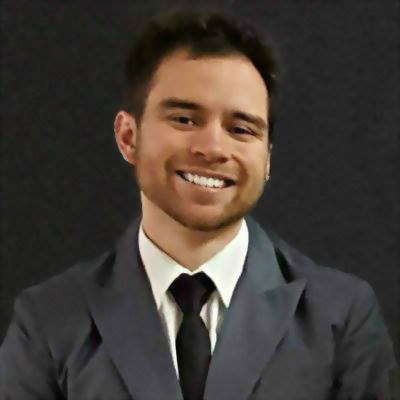Have you ever wondered what popular bloggers are doing that sets them apart from you? Or do you wish you knew what keeps your blog from receiving the attention it deserves?
At Growth Ramp, I work with early-stage startups to establish their growth strategy. SEO is one of the most common scalable marketing channels and blog content is often the vehicle to get more organic traffic.
But you can’t write articles and expect customers to magically visit your website. It’s critical to distribute and promote your content. So what sets apart the 1% of bloggers from the rest?
To answer this question, I partnered with Codeless and Orbit Media to study the content promotion strategies of bloggers and content marketers.
After the survey, we discovered:
- Only 38% of small bloggers document their content strategy. Yet 64% of all bloggers surveyed document their content strategy.
- Only 24% of small bloggers use influencer marketing to promote their content. Yet 41% of all bloggers use influencer marketing to promote their content. This includes using expert quotes, expert roundups, or influencer outreach as a way to get more traffic.
- Only 13% of small bloggers promote an article before it goes live. Yet 20% of all bloggers surveyed promote an article before it goes live.
- Small bloggers spend an average of 2 hours and 30 minutes writing articles. Yet the average all bloggers spend writing articles is 3 hours and 46 minutes.
- Small bloggers spend an average of 38 minutes promoting content. Yet all bloggers surveyed spend an average of 2 hours promoting their articles.
Those are major differences between what small bloggers do compared to the general blogger population.
And that’s not all we learned. After surveying 211 bloggers, we found answers to these eight questions:
- How much time does it take to write a typical article?
- How much time does it take to promote an article?
- How are bloggers driving traffic to their articles?
- How many bloggers use influencer marketing to promote their articles?
- What social media channel drives the most traffic to their blog?
- Do bloggers promote their content before an article goes live?
- Do bloggers have a documented content strategy?
- What is the average monthly blog traffic?
I’ll answer each of these questions in this article. At the end of each section, you’ll also find key takeaways to keep in mind to improve your blogging process.
Let’s dig into the data!
1. How much time does it take to write an article?
Every year for the past five years, bloggers have spent more time writing blog posts.
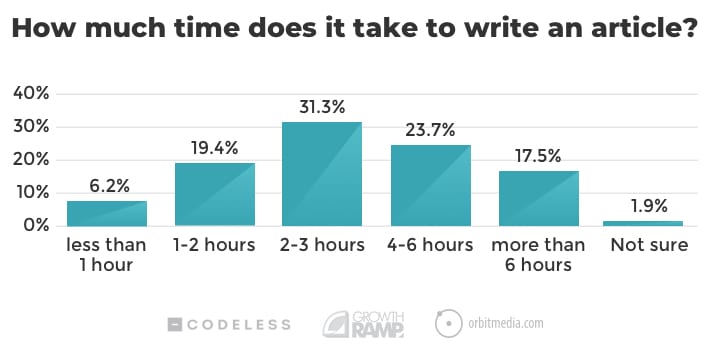
The average time spent writing an article is 3 hours and 46 minutes. The time it takes to write an article is up from 2 hours and 24 minutes in 2014.* That’s 57% more time!
Our number is very similar to what Orbit Media found in their blogger statistics survey: the average writer spent 3 hours and 28 minutes creating an article. We asked this question to see how similar the two populations were when comparing the two studies.
3 hours and 46 minutes sounds high. But it’s important for businesses to invest this time into their content, and more. William Harris, Head of Marketing at Elumynt explains:
 |
William harris, head of marketing, elumynt“Millions of articles go live every day. Most won’t get any traffic apart from ‘mom.’ Content writers need to spend more time becoming actual journalists. This means taking time to research the topic, do competitive analysis, outline it, write the article, edit the article, and then have it peer reviewed for quality. Writing content that gets shares means writing something that’s actually good. People can tell when something was written by a “writer” vs. a well-researched, informative, and accurate piece of content.” |
Most likely bloggers are spending more time creating higher quality articles.
Its possible bloggers are less efficient writers today than they were five years ago. There are many tasks bloggers need to do to stay competitive. As a result, they become less efficient at writing. But this seems unlikely because the average time spent increased 1 hour and 22 minutes.
This answer allows us to understand another important question:
What is the average cost of an article?
To calculate this, we will use the salary of a content writer and compare it to the time it takes to write an article. According to Glassdoor, the average pay of a content writer is $55,863 after bonuses.
This cost does not take into account payroll costs, SaaS tools, and other content marketing expenses. According to MIT, the extra costs are 1.25 to 1.4 times the base salary. Using the average of 1.325 times the base salary, the true cost of a content writer is closer to $74,018 a year.
Since it takes on average 3 hours and 46 minutes to write an article, the average cost of an article is $134.04. These are using US salaries.
Keep in mind if you are hiring contract writers, your quality may suffer paying below $134. The cost you pay doesn’t always reflect the value you receive, but there tends to be a connection.
 |
Kaleigh Moore, Freelance writer, kaleighmoore.com“Anyone can write an article and just ‘get it done’ for you. The value in paying more (sometimes 3-4X more) for articles is it gets you a subject matter expert who knows how to get into the nuance of a particular topic, thus positioning you as a thought leader and authority. Experts charge more and require more of an investment. But in my experience, that investment pays dividends.” |
Note: *To find the average time spent, we used the same approach Orbit Media used in their research. We took the average value of the range for each response. For example, if someone answered they spent 1-2 hours writing an article, it becomes 1.5 hours.
For anyone who answered “More than 6 hours,” we assigned the value of eight hours. We then averaged the time spent using these new numbers.
This process isn’t perfect. But it gave us more survey responses because bloggers did not need to know their exact number.
Key takeaways:
- The average time spent writing an article is 3 hours and 46 minutes.
- Bloggers spend 57% more time per article than in 2014, or an extra 1 hour and 4 minutes.
- The average cost for an article is $134.04.
2. How much time does it take to promote an article?
There’s a saying in blog culture:
“Bloggers should spend 80% of their time promoting an article, and 20% of the time writing an article.”
But do bloggers actually practice what they preach?
It turns out, bloggers spend about half the time promoting an article as they do writing one. Whoops! That’s eight times less than the popular saying goes.
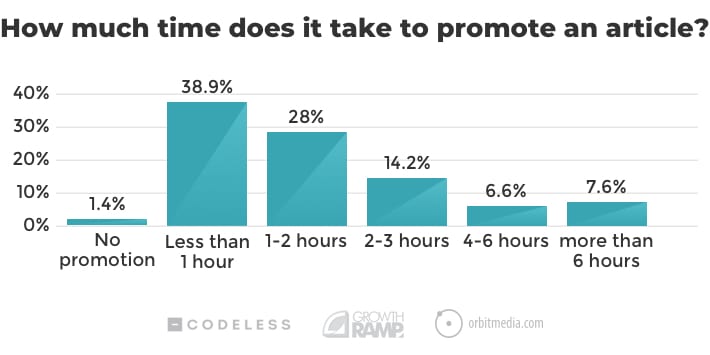
The average time a blogger spends promoting an article is two hours. That’s 47% less time promoting content compared to writing content!
Here are some possible explanations:
- Bloggers may focus more on writing a lot of content targeting many keywords. As I’ll discuss later, 78% of bloggers use SEO to drive traffic to their articles. If you do great keyword research, content promotion isn’t as necessary.
- Bloggers may not know how to effectively promote content four times as much as they write. As I wrote in my article on scaling promotion channels, bloggers need a constant stream of new ideas to scale blog growth. Sure, you could grind out more time on outreach for links. But that’s a painful and dull process.
- It’s often easier to automate content promotion than it is to write. Our team at Growth Ramp spends over 10 hours per article between writing and revisions. Once we post the article, Zapier automatically creates social updates for us. That takes no time but still drives results.
What is the average cost of promoting an article?
There’s no such thing as “free traffic.” Even if a blogger gets organic traffic, the blogger had to invest time into keyword research, on-page SEO, and other SEO activities.
The responsibility of content promotion often goes to a content writer, a social media marketer, or a content manager. The person’s title will change the effective cost of promoting an article. To keep it simple, I will use the salary of a content writer.
Using the same approach above, the effective average cost to promote an article is $71.17. With those kinds of content costs, you may be wondering why you should invest in content marketing.
 |
Claire Sullentrop, Co-Founder, Elevate“Paid acquisition channels are getting increasingly expensive, and will continue doing so. Relying too heavily on paid acquisition can kill a company. Don’t get me wrong. Content marketing is also getting more difficult. But its lasting advantage over paid channels is that it continues driving results over time, often years after you hit publish. Paid marketing ceases to drive value as soon as the ads are turned off. Companies ready to get serious about content marketing should plan to be in it for the long haul. This includes leveraging lots of community promotion, influencer promotion, and if there’s a budget, a bit of paid promotion to increase results.” |
Yes, content marketing costs are on the rise. But so are paid channels.
Key takeaways:
- The average time spent promoting an article is 2 hours.
- Bloggers spend 47% less time promoting an article than they do writing an article.
- The effective cost to promote an article is $71.17.
3. How are bloggers getting traffic to their articles?
We now know it takes two hours to promote content. So what are the channels bloggers are using?

It is interesting to compare our findings to Orbit Media’s blogger survey. When comparing the results, some key differences are:
- Bloggers appear to use social media less, from 96% to 86%.
- Bloggers appear to use SEO more, from 68% to 78%.
- Bloggers appear to use influencer marketing more, from 20% to 23%.
If you noticed, I used the phrase “appear to use.” This is because the sample data we collected may be from a different blogger population than Orbit Media’s blogger population.
- Orbit Media reached out mainly to those in their network. Given Orbit’s line of work, most likely there are more B2B bloggers. We reached out to those in our network, and to bloggers in many B2C niches including fashion, food, and finance.
- Orbit Media has a larger sample size and so their data more accurately represents the population they pulled from.
Why are more businesses and bloggers focusing on SEO, from 68% to 78%?
For starters, organic traffic isn’t easy for your competitors to steal.
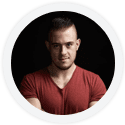 |
Kevin indig, Head of seo, G2“Content has become a moat for businesses. It can’t be taken away and it provides tons of benefits for businesses when done right. On the downside, it has become harder to get organic traffic. Google is delivering less organic traffic to sites and keeps more for itself. Bottom line: there are more benefits but a higher bar leads more bloggers to focus on SEO.” |
 |
Brendan hufford, Seo expert, brendanhufford.com“There’s a bit of FOMO that occurs when bloggers see their peers become successful with SEO. Bloggers are realizing organic visitors spend more time on their site, visit more pages, and convert at a higher rate than other promotion channels. In an age where businesses complain that email open rates are down and organic social media reach is dropping, pursuing SEO becomes a smart strategy that continues to pay off at a high rate.” |
Here’s another shocker.
85.8% of bloggers we surveyed are getting traffic to their articles through social media, yet only 48.8% use an email newsletter.
Everyone says the money is in “the list” (AKA, the email list). Yet it appears bloggers are still behind this trend.
 |
Paul Jarvis, Writer/Designer“I put my ‘business stock’ into newsletters. They have a high return on investment for me, but they also mean that I get to control my own platform. If I didn’t want to use Mailchimp anymore, I could export my list and import it into any newsletter software provider. Try exporting your ‘page likers’ from Facebook or even your followers on Twitter… oh wait, you can’t do that?! That’s because those platforms own your data and own your social connections, not you. They can also change the way you use their platforms, based on their whims. You want to reach your likers? It’s now $5 or more.” |
What are the other social media sites bloggers are using?
Youtube, MySpace, and Tumblr are three channels our bloggers mentioned.
Why Youtube?
Blogging has become more competitive. As such, bloggers are turning their articles into other forms of content such as video. This allows you to link to the article in the description of the video to drive traffic. Although you can host video content on many channels, YouTube is the traffic leader.
I bet you thought MySpace was dead. For the majority of bloggers, it is. But if you are writing in the music, movie, or in any other entertainment niche, it might be worth checking out.
Tumblr is another odd social network that’s still alive and kickin’.
With an estimated 555 million monthly visitors and 438.9 million blogs, there’s a brave new (err…old?) world out there.
Tumblr is a visual platform, with images making up 78% of posts. It’s a younger audience as those who are 18 to 24 years-old representing 28% of their audience. And you can make money on the platform, as Jason Wong sold over $200,000 in 21 days using Tumblr.
Key takeaways:
- Bloggers appear to use social media less, from 96% to 86%.
- Bloggers appear to use SEO more, from 68% to 78%.
- Bloggers appear to use influencer marketing more, from 20% to 23%.
4. How many bloggers use influencer marketing to promote their articles?
In the last four years, Orbit media reported roughly 1-in-4 to 1-in-5 bloggers used influencer marketing to drive traffic to their blog.
When we asked this question of our pool of people, we got a similar result. 23% of all bloggers said they used influencer marketing to drive traffic to their articles.
But when we asked the question in a different way, the response was nearly double, as you can see below:

In the second question, we phrased the question in a different way. We asked, “Do you use influencer marketing to promote your content, such as using expert quotes, roundups, or influencer outreach?” Here, 41% of bloggers said they used influencer marketing to promote their articles.
That’s a huge difference. Here are three possible reasons why:
- Some bloggers may view influencer marketing only as paying influencers to promote a product.
- Not everyone thinks of expert roundups or expert quotes as a part of influencer marketing.
- While many bloggers use this tactic, not all receive traffic. Not all influencers will promote content, even when asked to do so (you remembered to ask, right?). This tends to happen if your content isn’t true thought leadership.
Why is influencer marketing important to content marketing?
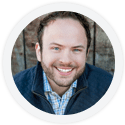 |
Lem Markidan, CEO, Podia“Your market already has people that they like, trust and look to for guidance on what to do and buy. Building relationships with those influencers is one of the most efficient ways to reach concentrated clusters of ready-to-buy customers with a single campaign. And the best part is that most influencers want to share high-quality products and services with their audience.” |
Working with influencers further increases your social proof. While press mentions are helpful, you and I relate more to individual people.
This is why companies like Nike invests millions a year into influencers (AKA celebrities) like Michael Jordan, LeBron James, and Derek Jeter. While you don’t have millions of dollars to invest into influencer marketing, many influencers are willing to help you for free if you provide value to them in a meaningful way.
Key takeaways:
-
- 41% of bloggers said they used influencer marketing to promote their content. This includes using expert quotes, roundups, or influencer outreach.
- 23% of bloggers said they used influencer marketing and outreach to drive traffic to their articles.
- The difference could be due to different definitions of influencer marketing. Or could be because not everyone knows how to do influencer marketing effectively.
5. What social media channel drives the most traffic to their blog?
Social media is the most used content promotion channel. So which social networks are driving the most growth? Here’s how bloggers responded:

Facebook has been a massive driver of traffic for blogs and news sites.
After the 2016 US presidential election, Facebook started to remove news from user feeds. Slate reported for every five people that came from Facebook a year ago, it now sends less than one person. From what I’ve noticed, this is true of all websites, not just news sites or blogs.
Still, Facebook is the #1 source of traffic among bloggers surveyed. With Facebook’s focus on building a global community, I would bet Facebook groups is a big opportunity.
I also believe Pinterest and Reddit are going to be bigger in 2019.
Pinterest does a brilliant job of bringing in new users through organic traffic. As a result, this drives ongoing organic traffic to people’s pins.
I’ve read of many bloggers getting more traffic from Pinterest than they do organic traffic. Yet I’ve noticed many Pinterest-focused bloggers don’t know how to do effective keyword research. So while I’m optimistic about Pinterest, I would not give up on SEO either.
Reddit can be challenging because results depend on users upvoting your content. But a well-timed link can send thousands of quality visitors to your site. That’s a lot harder for the average blogger to do on any other platform.
As mentioned in a previous question, some other social media channels bloggers mentioned are YouTube, Tumblr, and Myspace. Other social media sites include VKontakte (a Russian social network), Yammer, and WhatsApp.
Key takeaways:
- 32% of bloggers say Facebook drives the most traffic to their blog.
- I believe the biggest opportunities for bloggers in 2019 are Facebook Groups, Pinterest, Reddit, and YouTube.
6. Do bloggers promote their content before an article goes live?
What’s the best way to guarantee results? You stack the deck in your favor before you play your first hand. In the world of blogging, that means promoting your article before you even publish it.
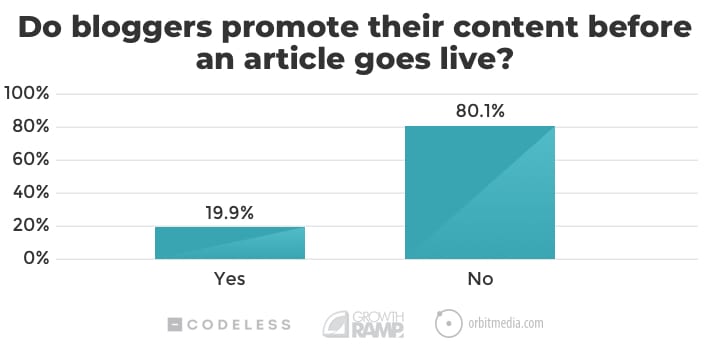
20% of bloggers said they promote an article before it goes live. Pre-promotion includes tactics like reaching out to influencers for a quote, doing email outreach to interested readers and creating a curiosity gap on social media.
As the blogging competition heats up, I expect to see more pre-promotion in the years ahead.
Key takeaway:
- 20% of bloggers said they promote an article before it goes live.
7. Do bloggers have a documented content strategy?
Not every blogger considers how content promotion effects content strategy. So we wanted to know how many bloggers document their content strategy.
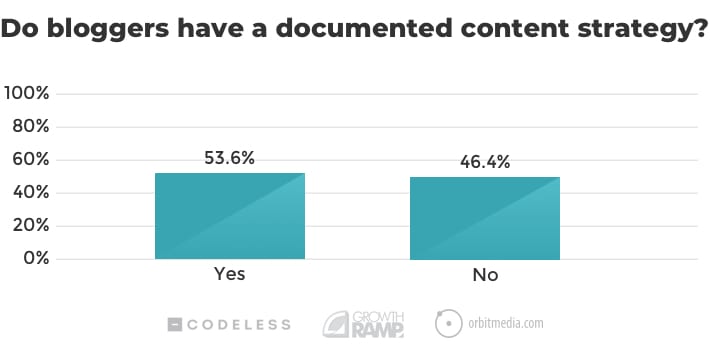
It turns out, 54% of bloggers surveyed have a documented content strategy. If bloggers are a one-man team, not documenting their strategy may not be an issue if you know your system. But communication becomes harder once you hire a second person to your team.
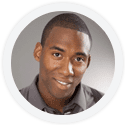 |
Ross Simmonds, Strategist“Bloggers who leap into content creation without a documented strategy are like drivers who hop behind a wheel without a map or GPS. Sure, you can get where you want to go, but not without a few wrong turns along the way. A documented strategy offers you clear direction around the topics and goals. One of the most common mistakes marketers point to is a lack of a documented plan. If you’re bringing someone onto your team, there’s nothing worse than a person having to guess what the priorities are, and what the strategy is for the blog. Strategy documentation might seem like a hassle. But it will save a lot of time and money long term.” |
Documenting your process will help you spend more time thinking about how to improve your promotion process, instead of trying to remember your process.
Key takeaway:
- Only 54% of bloggers have a documented content strategy.
8. What is the average monthly blog traffic?
As blogs grow, how bloggers promote content changes too. This is because the traffic needed to make an impact also increases. 1,000 visitors is phenomenal for a new blog. What about getting 1,000 visitors to an article for a blog that gets 1,000,000 visitors a month? Meh.
We wanted to make sure our survey asked bloggers with different traffic sizes. So we asked bloggers how many unique monthly users they receive:

As you can see, there are quite a few bloggers on the low end of the traffic curve. 48% of bloggers surveyed have less than 10,000 unique users a month.
This question allowed us to split up those we surveyed to get an idea what separates small bloggers from the general blogging population. As I wrote in the introduction:
- Only 38% of small bloggers document their content strategy. Yet 64% of all bloggers surveyed document their content strategy.
- Only 24% of small bloggers use influencer marketing to promote their content. Yet 41% of all bloggers who use influencer marketing to promote their content. This includes using expert quotes, expert roundups, or influencer outreach as a way to get more traffic.
- Only 13% of small bloggers promote an article before it goes live. Yet 20% of all bloggers surveyed promote an article before it goes live.
- Small bloggers spend an average of 2 hours and 30 minutes writing articles. Yet the average all bloggers spend writing articles is 3 hours and 46 minutes.
- Small bloggers spend an average of 38 minutes promoting content. Yet all bloggers surveyed spend an average of 2 hours promoting their articles.
The average monthly traffic bloggers get is 82,924 unique visitors a month. The median average monthly traffic bloggers get is 8,611 unique visitors a month. Because of how the traffic numbers are skewed, the median is a more accurate reflection of the average traffic bloggers receive.
Note: *The process we used here is the same process used to find the average time it takes to write an article. For anyone who answered “More 1,000,000 unique visitors a month,” we assigned the value of 1,500,000 visitors.
Key takeaways:
- The mean average monthly traffic bloggers get is 82,924 unique visitors a month.
- The median average monthly traffic bloggers get is 8,611 unique visitors a month.
Final thoughts
Mark Twain once said, “There are three kinds of lies: lies, damned lies, and statistics.”
We did our best to represent the data accurately. But there are always wrong assumptions you and I may make when looking at statistics. This study is no exception.
It’s wise to have a documented content strategy, but writing one won’t guarantee more traffic. Influencer marketing is a great opportunity to increase traffic. But it’s not a foolproof solution either. You can use this same logic when you looking at each survey question and our conclusion.
The goal of this study is to give a better idea of what you may need to do to drive more traffic to your blog.
A special thank you goes to Codeless and Orbit Media for partnering together with Growth Ramp on this survey.
